The Importance of Preparation in HVAC Sales
To increase your chances of success in HVAC sales, it is important to be well-prepared and gather relevant information about the customer and their specific needs. Preparation plays a crucial role in HVAC sales as it allows you to tailor your approach and address the customer’s pain points effectively. By knowing more about the customer’s situation, you can provide personalized solutions and build trust.
One way to prepare is by gathering information about the customer before the sales call. This includes understanding their HVAC system, any existing problems or concerns, and their preferred budget. By having this knowledge, you can demonstrate your expertise and offer tailored solutions that meet their needs. Additionally, calling the customer before arriving for the sales call helps establish a connection and build rapport, making them more receptive to your recommendations.
The Benefits of Preparation in HVAC Sales
- Improved communication: Being well-prepared allows you to communicate with confidence and clarity. You can articulate the benefits and value of your services, addressing the customer’s pain points effectively.
- Increased customer trust: By demonstrating your knowledge and preparedness, you build trust with the customer. They feel confident that you understand their needs and can provide reliable solutions.
- Enhanced sales performance: Preparation gives you a competitive edge and increases your chances of closing deals. When you can effectively address the customer’s concerns and offer personalized solutions, they are more likely to choose your services over competitors.
To succeed in HVAC sales, remember the importance of preparation. By gathering information about the customer, their specific needs, and fostering trust through effective communication, you can increase your sales performance and achieve greater success in your business.
Understanding the Customer’s Pain and Asking Quality Questions
To effectively address the customer’s needs and offer suitable solutions, it is crucial to understand their pain points and ask relevant and insightful questions. By doing so, HVAC sales reps can gather valuable information that will guide them in providing the best possible service.
One effective technique for understanding the customer’s pain is to empathize with their situation. By putting yourself in their shoes, you can better understand their frustrations and challenges. This empathy allows you to connect with the customer on a deeper level and gain their trust.
In addition to empathy, asking quality questions is key to uncovering the customer’s needs. Open-ended questions that encourage the customer to share more information can provide valuable insights into their specific requirements. These questions can help you determine their priorities, preferences, and budget, enabling you to offer tailored solutions.
| Open-ended questions: | Example: |
|---|---|
| What are your main concerns regarding your HVAC system? | What challenges are you currently facing with your HVAC unit? |
| How important is energy efficiency to you? | What features would you like to see in a new HVAC system? |
| What is your budget for HVAC repairs or replacements? | What are your expectations for the lifespan of a new HVAC system? |
By actively listening to the customer’s responses, you can gather valuable information that will help you recommend the most suitable HVAC solutions. Understanding the customer’s pain points and asking quality questions sets the foundation for a successful sales interaction.

Building Trust and Listening
Building trust with your potential customers is crucial to establish credibility and create a foundation for successful HVAC sales. When customers trust you, they are more likely to feel confident in your recommendations and choose your services. One effective strategy for building trust is to slow down and actively listen to the customer.
By listening carefully to their concerns, needs, and preferences, you show that you value their input and are genuinely interested in helping them. This can help you tailor your sales approach to their specific situation and offer solutions that meet their unique needs.
Additionally, taking the time to gather information about the customer and their situation before the sales call demonstrates your commitment to providing personalized service. By showing that you have done your homework and have a clear understanding of their needs, you establish yourself as a knowledgeable and trustworthy professional.
Benefits of Building Trust:
- Creates a positive impression and increases customer confidence
- Enhances customer satisfaction and loyalty
- Improves communication and understanding between the sales rep and the customer
- Increases the likelihood of repeat business and referrals
Remember, building trust is an ongoing process that requires consistent effort and genuine care for your customers. By prioritizing trust-building and actively listening to your customers, you can create long-lasting relationships and drive success in your HVAC sales.
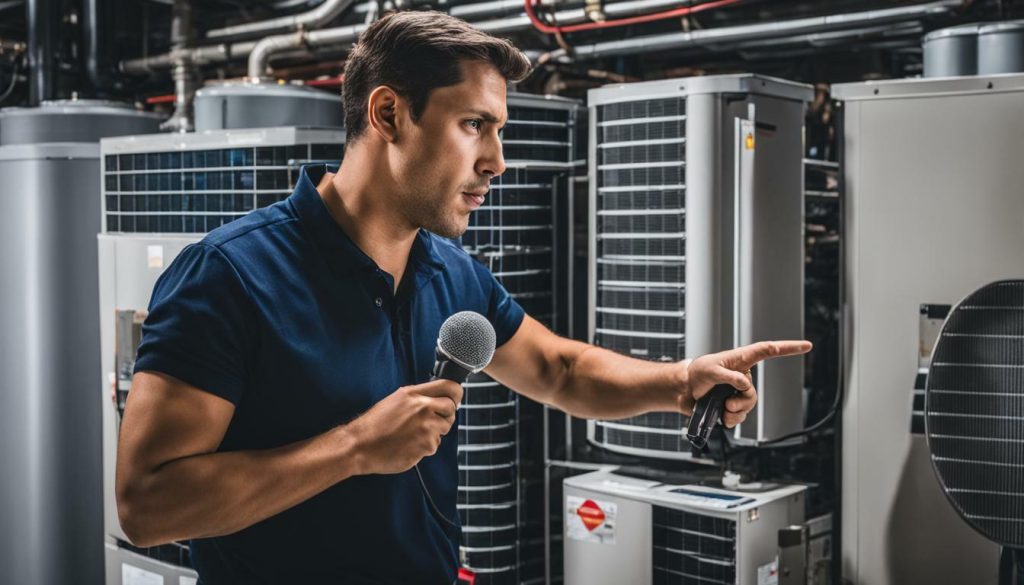
Explaining the HVAC Inspection Process
By clearly communicating the steps involved in the HVAC inspection process, you can help customers understand the value of your services and build confidence in your expertise. When customers have a clear understanding of what to expect during an HVAC inspection, they are more likely to trust your recommendations and feel comfortable moving forward with the necessary repairs or maintenance.
During an HVAC inspection, the technician will conduct a thorough assessment of the heating, ventilation, and air conditioning system. This includes checking the condition of the equipment, identifying any potential issues or safety concerns, and evaluating the overall efficiency of the system. By explaining these steps to customers, you can showcase the expertise and attention to detail that goes into each inspection.

| Benefits of Explaining the HVAC Inspection Process |
|---|
| 1. Transparency: Customers appreciate transparency and knowing exactly what is being done during an inspection. It helps establish trust and builds credibility for your services. |
| 2. Education: By explaining the process, you provide customers with valuable knowledge about their HVAC system. This empowers them to make informed decisions about repairs, upgrades, or maintenance. |
| 3. Peace of Mind: When customers understand the thoroughness of the inspection, they can have peace of mind knowing that their HVAC system is being thoroughly evaluated by a professional. |
Take the time to walk customers through each step of the HVAC inspection process, using clear and concise language. This can be done during the initial sales call or in person before the inspection begins. Use visuals, such as pictures or videos, to further illustrate the process and highlight any areas of concern. By effectively explaining the HVAC inspection process, you can provide customers with the knowledge and assurance they need to make informed decisions about their HVAC system.
Utilizing Visuals to Convince Customers
Visual aids such as pictures and videos can help customers visualize the problems with their HVAC unit and be convinced of the need for your services. When customers can see the issues with their own eyes, it becomes easier for them to understand why they should invest in HVAC repairs or maintenance.
By showing customers pictures of damaged components or videos of a malfunctioning system, you can effectively convey the urgency and importance of addressing the problem. Visual evidence is often more compelling than verbal descriptions alone, as it provides a tangible representation of the issue at hand.
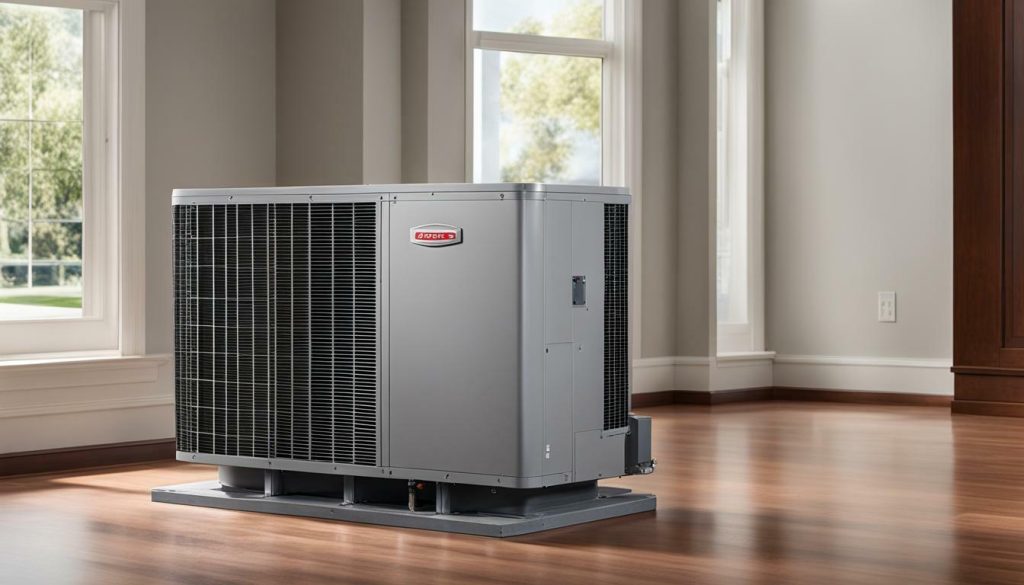
Incorporating visuals into your sales pitch can also enhance your credibility and professionalism. It demonstrates that you are prepared and knowledgeable about the specific problems affecting the customer’s HVAC system. This can instill confidence in your expertise, making customers more likely to trust your recommendations and move forward with the necessary repairs or upgrades.
| Benefits of Utilizing Visuals in HVAC Sales |
|---|
| 1. Enhances customer understanding of HVAC issues |
| 2. Adds credibility and professionalism to sales pitch |
| 3. Provides tangible evidence for customers to make informed decisions |
| 4. Increases customer trust and likelihood of converting the sale |
- Include pictures of damaged components
- Share videos of malfunctioning systems
- Highlight specific areas of concern
- Clearly explain how the visuals connect to the customer’s HVAC unit
Summary:
Utilizing visuals such as pictures and videos in HVAC sales can be highly effective in convincing customers of the need for your services. By providing tangible evidence of the issues affecting their HVAC unit, you can enhance their understanding, add credibility to your pitch, and increase their trust in your expertise. Incorporate visuals strategically into your sales process and clearly explain their relevance to the customer’s specific situation. By doing so, you can make a compelling case for your services and improve your chances of closing the sale.
| Key Points |
|---|
| 1. Visuals help customers visualize HVAC problems |
| 2. Visuals enhance credibility and professionalism |
| 3. Incorporate pictures and videos strategically |
| 4. Clearly explain the relevance of visuals to the customer’s situation |
Mentioning Monthly Payments and Financing Options
Making HVAC services more affordable and accessible by mentioning monthly payments and offering financing options can help overcome customer objections and increase sales. By providing flexible payment options, you can cater to a wider range of customers who may have budget constraints but still need your services. This approach not only makes your HVAC services more appealing but also demonstrates your commitment to customer satisfaction.
When discussing monthly payments, it’s important to clearly communicate the available options and their benefits. Whether it’s zero interest financing, low monthly installments, or extended payment plans, customers appreciate the transparency and flexibility provided. This empowers them to make informed decisions without worrying about immediate financial burdens.
| Benefits of Mentioning Monthly Payments and Financing Options |
|---|
| 1. Enhanced Affordability: By breaking down the cost into manageable monthly payments, customers can easily budget for HVAC services. |
| 2. Increased Customer Satisfaction: Offering financing options shows that you understand and care about your customers’ financial situations, leading to higher satisfaction levels. |
| 3. Competitive Advantage: Setting yourself apart from competitors by providing payment flexibility can give you an edge in the HVAC market. |
Moreover, mentioning financing options during the sales process instills confidence in customers, as it demonstrates your professionalism and commitment to helping them find effective solutions. It allows them to focus on the benefits and value of your services, rather than being hindered by immediate financial constraints.
By incorporating monthly payments and financing options into your HVAC sales pitch, you can address customer objections, increase sales conversions, and ultimately build long-term relationships with satisfied customers.

Table: Benefits of Mentioning Monthly Payments and Financing Options
| Enhanced Affordability | Increased Customer Satisfaction | Competitive Advantage |
|---|---|---|
| By breaking down the cost into manageable monthly payments, customers can easily budget for HVAC services. | Offering financing options shows that you understand and care about your customers’ financial situations, leading to higher satisfaction levels. | Setting yourself apart from competitors by providing payment flexibility can give you an edge in the HVAC market. |
Getting a Clear Next Step
By providing a clear next step, you can maintain momentum and encourage the customer to take action, ultimately leading to successful HVAC sales. After discussing the customer’s needs and explaining the value of your services, it’s important to guide them towards the next logical step in the sales process.
One effective way to do this is by offering a specific call to action. For example, you could suggest scheduling an on-site consultation, signing up for a free estimate, or even encouraging them to make a purchase decision right away. By giving the customer a clear direction, you remove ambiguity and make it easier for them to move forward with the sales process.
To reinforce the importance of the next step, you can also summarize the benefits and outcomes they can expect from taking action. Highlight how your services will solve their problems, improve their comfort, and provide long-term cost savings. This can help create a sense of urgency and motivate the customer to take the next step immediately.
| Benefits of a Clear Next Step: |
|---|
| 1. Removes ambiguity and confusion for the customer |
| 2. Provides a sense of direction and purpose |
| 3. Motivates the customer to take action |
| 4. Reinforces the value and benefits of your services |
Example Next Steps:
- Schedule an on-site consultation
- Sign up for a free estimate
- Make a purchase decision right away
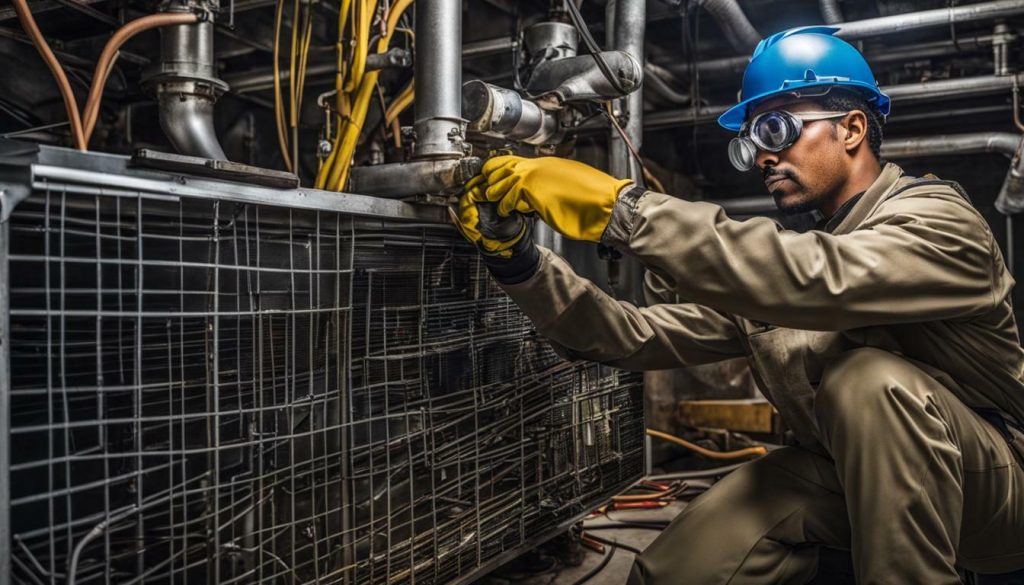
By following these strategies and consistently providing a clear next step, you can improve your HVAC sales performance. Remember to tailor the next step to the specific needs and preferences of each customer, ensuring that it aligns with their timeline and priorities. With a proactive approach and effective communication, you can guide customers towards making informed decisions and ultimately close more sales.
The Four C Approach: Contact, Connect, Convince, Convert
The Four C approach, consisting of contact, connect, convince, and convert, provides a structured framework for HVAC sales and can enhance your sales techniques. By following these steps, you can effectively engage with customers, build relationships, address their needs, and ultimately convert leads into sales.
Contact
The first step in the Four C approach is contact. This involves reaching out to potential customers through various channels such as cold-calling, email, or social media. When making initial contact, it is important to introduce yourself and clearly explain the purpose of your call or message. By establishing a friendly and professional tone from the start, you can make a positive impression and increase the likelihood of further engagement.
Connect
Once you have established contact, the next step is to connect with the customer on a personal level. Building rapport and trust is crucial in HVAC sales. Take the time to listen actively and show genuine interest in the customer’s concerns and needs. This will help you establish a strong connection, demonstrate empathy, and position yourself as a trusted advisor.
Convince
After establishing a connection, it is time to convince the customer of the value and benefits of your HVAC services. This stage involves effectively communicating the unique selling points of your offerings and addressing any doubts or objections the customer may have. Utilize visual aids such as pictures and videos to showcase the problems and solutions, helping the customer visualize the benefits.
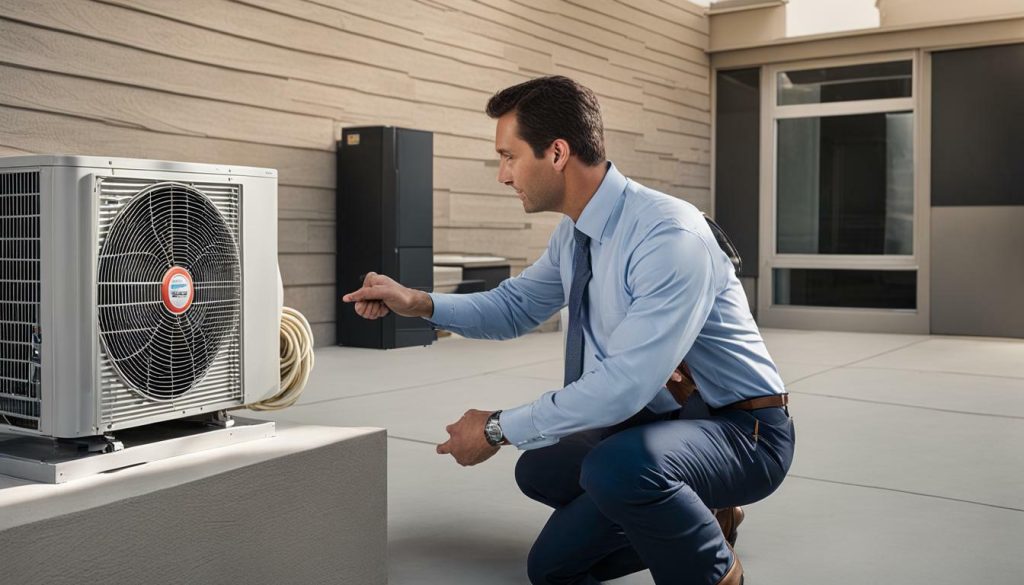
Convert
The final stage of the Four C approach is convert. This is where you seal the deal and turn the prospect into a paying customer. To successfully convert leads, it is important to clearly outline the next steps, such as scheduling an appointment or providing a quote. By guiding the customer towards a clear next step and confirming their commitment, you can solidify the sale and ensure a smooth transition to the next phase of the customer journey.
By implementing the Four C approach in your HVAC sales process, you can enhance your sales techniques and increase your chances of success. Remember, effective contact, connection, convincing, and converting are the keys to achieving your sales goals and building long-lasting customer relationships.
Boosting Cold-Calling Skills through Training
Enhancing your cold-calling skills through training can significantly improve your HVAC sales performance and increase your success rate. Cold-calling is an essential aspect of selling HVAC services, and by honing your skills, you can build stronger connections with potential customers and close more deals.
One effective way to improve your cold-calling skills is by participating in sales training programs specifically designed for HVAC sales professionals. These programs provide valuable insights and techniques that can help you navigate through challenging conversations and objections. Training sessions often cover topics such as effective communication, objection handling, and building rapport with customers.
During training, you will learn techniques to engage customers from the first moment of the call and how to deliver a compelling sales pitch. You will also gain confidence in handling objections and learn strategies to turn them into opportunities for persuasion. By practicing these techniques in a safe and supportive environment, you can refine your cold-calling skills and increase your chances of success.

Table: Benefits of HVAC Sales Training
| Benefits | Description |
|---|---|
| Improved Communication | Trainings help you develop better communication skills, allowing you to connect with customers more effectively. |
| Enhanced Confidence | By mastering proven sales techniques, you will gain confidence in approaching potential customers and addressing their concerns. |
| Increased Sales Conversion | Training equips you with the knowledge and skills to handle objections, build trust, and ultimately close more sales. |
| Expanded Product Knowledge | Through training programs, you will gain a deeper understanding of the HVAC products and services you are selling, enabling you to provide comprehensive information to customers. |
By investing in HVAC sales training, you can sharpen your cold-calling skills and position yourself as a confident and knowledgeable HVAC sales professional. Remember, continuous learning and practice are essential for success in any sales role. With the right training and dedication, you can elevate your sales performance and achieve your goals.
Overcoming HVAC Sales Objections and Negotiation
Overcoming objections and negotiating effectively play a crucial role in HVAC sales. By utilizing proven strategies, you can address customer concerns and reach mutually beneficial agreements.
One common objection in HVAC sales is the cost of the services. To overcome this, emphasize the long-term benefits and energy savings that the customer will receive by investing in your HVAC solutions. Provide specific examples and data to support your claims. Additionally, offer flexible financing options or discounts to make the investment more affordable for the customer.
Another objection you may encounter is a lack of trust or skepticism about your services. To overcome this, build trust by sharing testimonials or case studies from satisfied customers. Use visuals such as images or videos of successful HVAC installations to showcase your expertise. Address any doubts or concerns directly and provide evidence to support the value and quality of your services.
| Objection | Strategy |
|---|---|
| Cost of services | Emphasize long-term benefits and offer flexible financing options or discounts |
| Lack of trust or skepticism | Share testimonials, case studies, and visuals to build trust and credibility |
| Competition | Highlight unique selling points, warranty, and exceptional customer service |
| Timing | Create a sense of urgency through limited-time offers or seasonal promotions |
Dealing with competition is another objection you may face. To overcome this, highlight your unique selling points, such as extended warranty, energy-efficient solutions, or exceptional customer service. Differentiate yourself from competitors by offering added value and demonstrating your commitment to customer satisfaction.
Lastly, timing can be an objection, especially if customers are hesitant to make decisions. Create a sense of urgency by offering limited-time offers or seasonal promotions. Highlight the benefits of acting now, such as avoiding potential breakdowns during extreme weather conditions or taking advantage of cost savings before prices increase.
In conclusion, overcoming objections and negotiation skills are essential in HVAC sales. By addressing customer concerns, building trust, and providing value, you can effectively close deals and achieve success in your HVAC sales endeavors.
Key Strategies:
- Emphasize long-term benefits and offer flexible financing options or discounts to overcome cost objections
- Build trust through testimonials, case studies, and visuals of successful HVAC installations
- Highlight unique selling points, warranty, and exceptional customer service to address competition objections
- Create a sense of urgency through limited-time offers or seasonal promotions to overcome timing objections
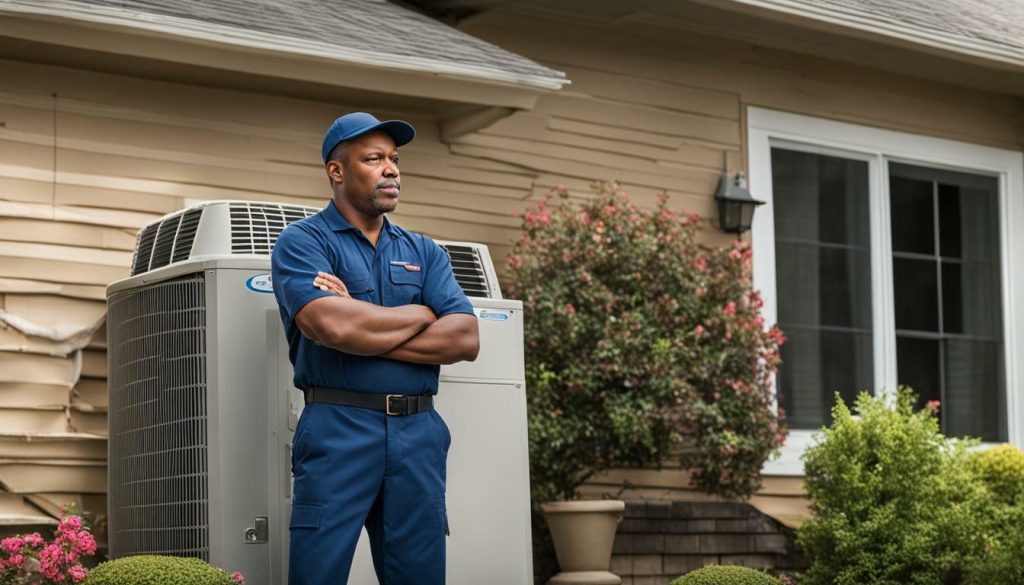
Conclusion
Developing effective HVAC sales scripts and implementing proven sales strategies can significantly boost your HVAC business and lead to greater sales success. By having the right approach and mindset, HVAC sales reps can effectively communicate with customers and increase their sales.
Preparation is a key factor in HVAC sales. Taking the time to gather information about the customer and their situation before the sales call can make a huge difference. It allows you to tailor your pitch to their specific needs and demonstrate that you understand their pain points.
Building trust and rapport with customers is crucial. Calling the customer before arriving not only helps you gather more information, but it also shows that you value their time and are committed to providing excellent service. During the sales call, it’s important to slow down, actively listen, and ask quality questions to uncover the customer’s problems and needs.
Explaining the steps involved in the HVAC inspection process helps customers understand the value of your services. By sharing visuals such as pictures and videos of the HVAC unit, you can effectively demonstrate the problems and convince customers to invest in your services.
Mentioning monthly payments and offering financing options can make HVAC services more accessible to customers, increasing the likelihood of closing the deal. Finally, ending the sales call with a clear next step and a confirmation statement helps solidify the customer’s understanding and commitment.
By following these strategies and using the Four C approach (contact, connect, convince, convert), you can improve your cold-calling skills and successfully sell HVAC services. Remember, effective sales scripts, preparation, active listening, trust-building, and utilizing persuasive techniques can all contribute to your success in the HVAC sales industry.
FAQ
Why is preparation important in HVAC sales?
Preparation is crucial in HVAC sales as it allows you to gather information about the customer and their situation before the sales call. This helps you tailor your approach and increase your chances of success.
How can calling the customer before arriving help in HVAC sales?
Calling the customer before arriving builds trust and rapport. It shows that you value their time and allows you to establish a connection before the sales call, increasing the likelihood of a successful sale.
Why is understanding the customer’s pain and asking quality questions important in HVAC sales?
Understanding the customer’s pain points and asking quality questions helps uncover their problems and needs. This allows you to provide tailored solutions and demonstrate how your HVAC services can effectively address their concerns.
How can I build trust and actively listen to the customer in HVAC sales?
Building trust involves slowing down, listening attentively, and showing genuine interest in the customer’s needs. Active listening helps you understand their concerns and enables you to address them effectively, building a strong rapport in the process.
How can I effectively explain the HVAC inspection process to potential customers?
Explaining the steps involved in the HVAC inspection process helps customers understand the value of your services. Breaking down the process into understandable terms and addressing any concerns they may have ensures transparency and builds confidence in your expertise.
How can I utilize visuals to convince customers in HVAC sales?
Sharing pictures and videos of the HVAC unit can effectively demonstrate the problems and convince customers of the need for your services. Visual aids provide tangible evidence, making it easier for customers to understand the issues and make an informed decision.
How can mentioning monthly payments and financing options help in HVAC sales?
Mentioning monthly payments and offering financing options can make HVAC services more affordable and accessible to customers. This flexibility increases the likelihood of closing deals as it addresses any financial concerns they may have.
How can I guide the customer towards a clear next step in HVAC sales?
Ending the sales call with a clear next step, such as scheduling an appointment or discussing further details, solidifies the customer’s understanding and commitment. Providing a clear path forward ensures that progress is made and increases the chances of closing the sale.
What is the Four C approach in HVAC sales?
The Four C approach refers to Contact, Connect, Convince, and Convert. It is a framework that helps HVAC technicians improve their cold-calling skills and successfully sell HVAC services. Each stage focuses on specific actions and strategies to guide potential customers through the sales process effectively.
How can I boost my cold-calling skills in HVAC sales?
Improving cold-calling skills can be achieved through sales training and practice. By learning effective techniques, such as establishing rapport, addressing objections, and utilizing persuasive communication, you can enhance your cold-calling abilities and improve your chances of success.
How can I overcome objections and negotiate effectively in HVAC sales?
Overcoming objections requires active listening, addressing concerns, and providing solutions. Negotiation skills involve finding common ground, understanding customer needs, and presenting mutually beneficial options. By mastering these techniques, you can navigate objections and negotiations successfully.





0 Comments